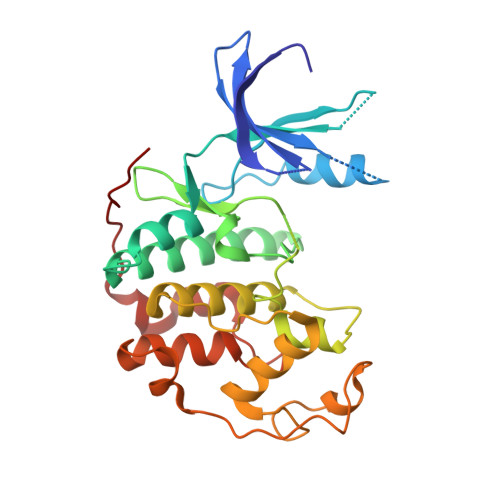The discovery of a new structural class of cyclin-dependent kinase inhibitors, aminoimidazo[1,2-a]pyridines.
Hamdouchi, C., Keyser, H., Collins, E., Jaramillo, C., De Diego, J.E., Spencer, C.D., Dempsey, J.A., Anderson, B.D., Leggett, T., Stamm, N.B., Schultz, R.M., Watkins, S.A., Cocke, K., Lemke, S., Burke, T.F., Beckmann, R.P., Dixon, J.T., Gurganus, T.M., Rankl, N.B., Houck, K.A., Zhang, F., Vieth, M., Espinosa, J., Timm, D.E., Campbell, R.M., Patel, B.K., Brooks, H.B.(2004) Mol Cancer Ther 3: 1-9
- PubMed: 14749470
- Primary Citation of Related Structures:
1PYE - PubMed Abstract:
The protein kinase family represents an enormous opportunity for drug development. However, the current limitation in structural diversity of kinase inhibitors has complicated efforts to identify effective treatments of diseases that involve protein kinase signaling pathways. We have identified a new structural class of protein serine/threonine kinase inhibitors comprising an aminoimidazo[1,2-a]pyridine nucleus. In this report, we describe the first successful use of this class of aza-heterocycles to generate potent inhibitors of cyclin-dependent kinases that compete with ATP for binding to a catalytic subunit of the protein. Co-crystal structures of CDK2 in complex with lead compounds reveal a unique mode of binding. Using this knowledge, a structure-based design approach directed this chemical scaffold toward generating potent and selective CDK2 inhibitors, which selectively inhibited the CDK2-dependent phosphorylation of Rb and induced caspase-3-dependent apoptosis in HCT 116 tumor cells. The discovery of this new class of ATP-site-directed protein kinase inhibitors, aminoimidazo[1,2-a]pyridines, provides the basis for a new medicinal chemistry tool to be used in the search for effective treatments of cancer and other diseases that involve protein kinase signaling pathways.
- Lilly Research Laboratories, Eli Lilly and Company, Lilly Corporate Center, Indianapolis, IN 46285, USA. hamdouchi_chafiq@lilly.com
Organizational Affiliation:

















